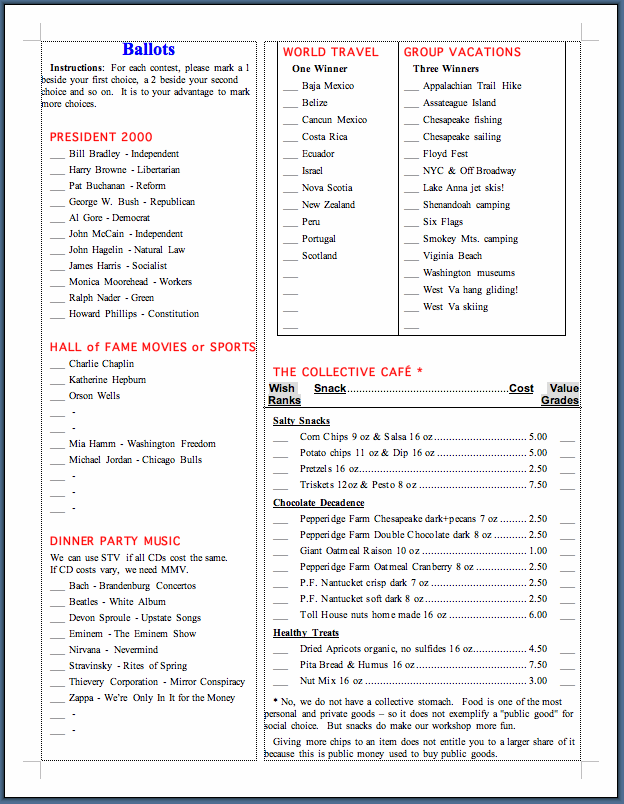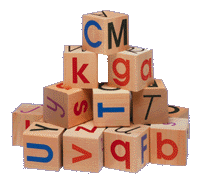|
Different uses for voting
need different types of voting. |
 |
Materials for
|
 |

|
This page describes several ways of making tally boards and visible votes. It follows the Instructor's Guide to Tabletop Tallies. The Tally BoardTransferable votes can be taught with no equipment. The voters stand in lines behind their candidates. The weakest ones are eliminated one at a time. When a candi-date loses, each voter in that line walks to stand behind his or her next choice. But in many classes this leads to chaos as people push to stand near their friends; the idea of transferable votes is forgotten. Standing in line cannot let voters reset a dozen budgets.Paper ballots and a board with cards teach more. They show how ranks marked on a ballot direct its vote to suc-cessive favorites. The first tally board for Budget Refill Voting was just a table. The cards were an inch wide by a half-inch tall (about 2 cm by 1 cm). Those were too small and hard to place in columns. A breeze could blow some out of position. A quick and easy board uses thick "card stock" paper. Folded accordion style, it forms col-umns. These hold V-shaped cards made of the same pa-per. The paper columns can lie on a table; but only a few people standing around the table can see them. The panels could lean back on a wall; but then the cards tend to slide down over each other. The best tally boards use slats glued to a board. The slats hold cards in columns and keep them from slid-ing. Coroplast with slats from a venetian blind make a durable water-proof tally board. Pieces of cardboard with card-stock slats work OK. The board in the photos uses the side from a baby crib and white Coroplast. The slats hold cards in two-inch columns. To fit these columns, the election cards are four inches wide by two inches tall. There are half-size and double size cards for spending votes. All cards are made of the heaviest "card stock" that the printer can handle. A user’s manual should list a printer’s maximum. Be sure to reset your printer for thick paper before printing. The newest tally board keeps the Coroplast back-board and replaces the crib slats with vanes from a Venetian blind. These make the new board much lighter. The next tally board will rivet those vanes (or ¼ round strips cut from 1” PVC pipe) on both sides of a white cloth. We might use stiff old sailcloth. This will let the “board” roll up to go in luggage. How Big Should a Tally Board Be?IRV needs columns tall enough to hold half the cards plus one. You can stack a pair of short panels. Mul-ti-winner decisions have shorter columns but usually have more candidates needing more columns. So panels go side by side. Voting CardsYou may download whole sets of cards compressed to 154K or 20K. The prettiest are two-inch cards with pic-tures of letters, in Word files. The most adaptable are cards in Excel, 2" by 1" (5 cm by 2.5 cm). Each set has 5 cards for each of 26 letters. You can easily create cards for more voters by using underlined letters, colored letters, lower-case fonts, and colored paper. A favorite voting board: A reassuring and playful design uses wooden al-phabet blocks as cards. Voters place their blocks between the bars of an old playpen or crib. “Does anybody feel threatened by all this high technology?” No. It disarms people who come ready to quip that movable votes are too complicated. Planks form bases for vertical dowels; these fit holes drilled through the cards. A voter slips his card over the top of a dowel and slides it down. This can hold cards secure it until that column wins or loses; then the teacher slides all its cards off the top. Sources
Alphabet blocks: Notice that both of these block sets (from Melissa and Doug Wooden Toys and Uncle Goose Wooden Toys) like most, have more than one letter on each block. That won't work. Painting, sanding or sawing off a letter is laborious so finding or making single-letter blocks is worthwhile. Good ones are hard to find and sometimes expen-sive. Nod Blocks are $58 with shipping. The Muse-um Store's are only $20, but they are not embossed. Plain letter blocks are easy to make with low-cost blocks and transfer letters from craft stores.
Elect One Winner by IRVTo show the affect of voting districts, tally the plurality winner for each dozen voters as they place their initial votes. In homogeneous groups, students can help the demonstration if some vote the opposite of their true feelings. A dice or coin toss can break ties here. A better way to break ties asks you to note the number of cards in each stack after each round of moving votes. If two candidates tie for last place, eliminate the one with the fewest votes in the previous round.
Elect a Council by STVYou can show the transfer of excess votes from a winner us-ing thin cards to represent the partial weights transferred from the winner to each voter's next choice.
Select Several Projects by MMVIn the Transferable Allocation Sys-tem (MMV) a project’s cards must fill its column; a costly project must fill a wide column. If each project costs some multiple of $100, a project that costs $200 has a double-wide column. If the bylaws say a project needs at least 12 sup-porters (to prove it has broad support) then columns are 12 cards tall. Every 12 cards will fill a $100 column so hand out 12 cards for every $100 in the fund.Each voter receives a set of cards to represent his share of the project funds. He may place only 1 card in a single column; 2 cards (horizontally) in a double column and so on. A voter might receive 2 single cards and 1 double card to represent his $50 share of the overall budget for pro-jects. The usual strategy is to put the double card vertical-ly in your favorite column to raise that project quickly. This way, 6 enthusiastic supporters can fund 1 low-cost project. { Teachers might give each student three whole cards or give a half card, a whole card and a one-and-a-half card. Either way each student gets three cards with an average vote of one. (A voter may choose his own "utility curve". if his bag of cards includes two whole cards with upper-case "ID" labels and two half cards, only one of which has an upper-case label. The remaining half card has an lower-case "id" and must be attached to another card.) { If his first choice had two columns to fill, he could give it his two largest cards. { But card sizes make manual transfers harder: If a first choice is eliminated, the voter wants to move his big-gest card to his second choice; his next biggest card from second to third choice and so on. So all cards must be easy to move, and when moving a bigger card into a column, it helps if the cards above can slide up. (Stickums can't do that, so three equal stickums work better.) Computer ballots make the process much easier: just rank the proposals once; the com-puter does the rest.
Adjust Agency Budgets with BIPA board for Budget Refill Vot-ing (BRV) has several columns for a costly agency, as MMV did for a costly project. But no agencies will be eliminated; supporters just vote to raise an agency's fund-ing. Each column of an agency begins the tally [$1000] below a baseline — which may be last year's level or one set by a Median Voter Pro-cess. Supporters may push an agency above its base-line, but its gain will be another's loss.Say 20 voters are setting budgets for 7 agencies, 4 small and 3 big. They decide each agency will need moderate support from 12 voters to reach its basic funding. So a single column usually needs 12 cards to reach its baseline. But 6 resolute voters using their double cards could restore funding for a small agency. In this example, each voter gets 6 cards:
Equipment for budget voting must let a voter quickly lower his vote for a budget he feels has gone too high. So the board must not lock his card in the middle of a col-umn. The colorful coroplast design works and the antique design works if it can hold alphabet blocks between pairs of dowels. A tech design uses columns of wire with 4 vertical wires held parallel by a few circular hoops. The cards have personalized IDs printed on colored Mylar or thick "card stock" paper, then cut and rolled in cylinders of various lengths: 1½, 1, ½. Voters can squeeze these out between the wires from any side — so many voters can surround a column during budget votes. For STV votes, an ID paper may wrap around a hard 1" dowel or PVC pipe, so it can slide in and out only at the top of the shoot. The rules may let voters push an agency down with negative cards, and/or push overall spending up or down. (If the rules do not let a voter change overall spending, he must put the same number of positive and negative cards on different agencies.) Columns for the negative red cards are paired with columns for black positive cards. ' , ' , ' , An agency starts at its baseline, not below. When its yellow cards are higher than its blue cards, its funding has increased by that dif-ference. { The countertop BIP rule is not really in the family of rules which includes IRV, STV and MMV. Instead, it is simplified from the Influence Point rule by Hylland-Zeckhauser as implemented in software for this web site. [On-line "cards" are easier to move than real cards and any number of voters fit at the "board".]
SummaryYou can change the candidates on the sample ballot below by downloading a copy of this page formatted for Word 6 .doc, generic word processor format .rtf, or Adobe Acrobat .pdf. You also may download a choice ballot, free software and cards format-ted in Word or Excel.)
Transferable vote rules are the best at distributing winners to interest groups. But this hints that they are not the best rules for picking the one central candidate with the broadest support from all groups. That goal will be the topic of the next chapter. |


|
|







 Accurate Democracy
Accurate Democracy 








